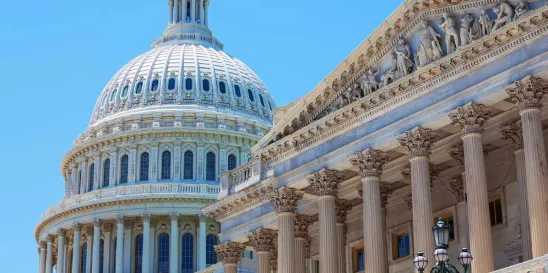Federal appropriations provide annual discretionary funding for our government to carry out its mission and, in turn, spur various healthcare organizations towards efficiencies and achievements. Whether you serve an entity interested in the government’s work in disease research or a nonprofit hospital requesting community project funding for infrastructure needs, it is important for those seeking funding provided through Congress’ annual appropriations cycle to understand the process and current legislative landscape.
This year more than most, the process is complex – with timelines that abut and potentially overlap. Fiscal Year (FY) 2024 began on October 1, 2023; in the absence of completed spending bills, government programs are currently being funded via a series of short-term stop-gap funding bills. Lawmakers are still negotiating FY 2024 funding levels, which will expire on September 30. FY 2025 begins on October 1, and the process for determining appropriations for the upcoming fiscal year will begin shortly.
(1) What is the annual appropriations process?
Congress has the power of the purse, as provided by the Constitution: “No money shall be drawn from the Treasury, but in Consequence of Appropriations made by Law” (Article I, Section 9). This language translates to lawmakers’ ability to pass discretionary budget authority – about one-third of all federal expenditures – to federal departments or agencies for specified purposes. Should appropriations not be passed for a fiscal year, or extended from the previous year, the portion of the federal government that lacks the discretionary spending shuts down.
A timetable for the development and consideration of annual budgetary legislation was established through the Congressional Budget Act of 1974. This timetable outlines the various steps of the congressional budget process, though the deadlines are often delayed.
While the President is expected to submit to Congress his proposed budget for the ensuing fiscal year by the first Monday in February, this deadline is rarely met. Once the budget request is submitted to Congress, House and Senate authorizers and appropriators begin the process of reviewing the congressional justifications (budget proposals) of every federal agency and program.
Congress is also expected to pass a budget resolution, which provides lawmakers the requirements for all budget-related legislation, including the topline spending level – often referred to as the 302(a) allocation – governing discretionary spending for that fiscal year.
The House and Senate Committees on Appropriations are responsible for accepting funding requests from all lawmakers in their respective chambers. Appropriations bills have, in recent years, offered three notable areas for engagement: (1) community project funding/congressionally directed spending (colloquially referred to as “earmarks”), (2) programmatic funding, and (3) report language.
- Community project funding/congressionally directed spending directs funding to specific, approved entities, such as nonprofit organizations and local governments.
- Programmatic funding provides funding for specific government operations.
- Report language provides direction from the committee to an agency on how it should use appropriated funds; while this language does not carry the force of law, agencies often abide by report language because it provides context and congressional intent.
In a regular-order scenario, each chamber’s lawmakers mark up and amend each of the 12 annual spending bills in subcommittee and full committee before reporting the bills to the floor for additional amendments and final approval. Upon approval, the chambers engage in a process to reconcile the differences between the House and Senate versions of each bill. The President signs the compromise bills (known as conference agreements) into law or vetoes the legislation, starting the process over again.
Because appropriations bills must be considered on an annual basis, the end of the fiscal year – September 30 – puts a hard deadline on a short process. If lawmakers recognize their negotiations may not meet the fiscal year deadlines, they may enact a “continuing resolution” (“CR”), a stopgap measure that extends the previous year’s funding levels and associated authorities and conditions. A CR allows continued funding until lawmakers pass another CR or a new appropriations bill, thus averting a government shutdown.
(2) Where does the FY 2024 appropriations process stand?
FY 2024 began on October 1, but lawmakers were unable to enact any FY 2024 appropriations bills by that date. However, each chamber did make progress and advance bills on their own: the House passed seven bills, and the Senate passed three bills.
After an initial month-long CR at the end of September 2023, Congress passed (and President Biden signed) another CR in November. This November CR used a “laddered” approach to extend the appropriations process, bifurcating the 12 appropriations bills into two tranches with separate expiration dates: the first tranche, consisting of four bills, was to expire on January 19, and the second tranche, consisting of the remaining eight bills, was to expire February 2.
In early January, House and Senate leadership released an agreement on topline funding levels to govern the FY 2024 appropriations process. House and Senate appropriators must now strike a deal on subcommittee allocations (the distribution of the topline funds to the 12 appropriations subcommittees, often referred to as 302(b) allocations) to allow subcommittees to complete negotiations on the conference agreements.
House and Senate appropriators and their professional staff must resolve a myriad of funding and policy differences and complete negotiations on an accelerated timeline. To allow for this significant work, lawmakers again extended the FY 2024 funding deadlines through an additional CR. On January 19, President Biden signed this additional CR into law.
The following four bills were extended until March 1 via the January CR:
- Agriculture, Rural Development, Food and Drug Administration, and Related Agencies;
- Energy and Water Development and Related Agencies;
- Military Construction, Veterans Affairs, and Related Agencies; and
- Transportation, Housing and Urban Development, and Related Agencies.
The following eight bills were extended until March 8 via the January CR:
- Commerce, Justice, Science, and Related Agencies;
- Defense;
- Financial Services and General Government;
- Homeland Security;
- Interior, Environment, and Related Agencies;
- Labor, Health and Human Services, Education, and Related Agencies; and
- State, Foreign Operations, and Related Programs.
(3) What is to be expected with the FY 2025 appropriations process?
As Congress works to wrap up the FY 2024 appropriations process in early March, it is likely the FY 2025 cycle will begin in earnest shortly thereafter – starting with President Biden’s submission of his budget request to Congress.
The ability of the House and Senate Committees on Appropriations to advance FY 2025 spending bills in a timely fashion will be largely dependent on agreeing to topline funding levels and subcommittee allocations. In the absence of an agreement on FY 2025 funding bills, Congress will need to approve a CR by September 30.
It is unlikely the FY 2025 appropriations process will conclude by November, as the elections will determine which political party controls the White House, the House, and the Senate. Notably, in prior presidential election years, efforts have been made to finish appropriations work – without a CR – before the beginning of the new Congress in January, even if it means tackling budget questions during a lame duck session at the end of the year.
(4) How should an organization prepare for the FY 2025 appropriations process?
With each year’s appropriations process delayed, organizations may question the timing of their requests in this confusing and political environment. Should organizations make their FY 2025 requests now, as lawmakers wrap up FY 2024 funding? Should organizations wait to understand the FY 2025 process and timing? What about making the request once the November elections are in the rearview mirror?
There is no time like the present to consider an appropriations approach. Whether your organization is reengaging on a prior year’s ask or vetting a new initiative to determine if it is viable under the federal appropriations rules and guidance, the pace of the process means determining funding priorities and strategy as early as possible is the best formula for success. The timing for requests can be short – perhaps a few weeks or a month – leaving a short period to discuss and debate ideas before submission, and certainly no time to delay until after election season. Ideally, organizations should have an understanding of which lawmakers may champion their request, based on the elected official’s interests and legislative priorities; meeting with these congressmen and senators and their legislative staff during this short window could also enhance an application for funding.





 />i
/>i
